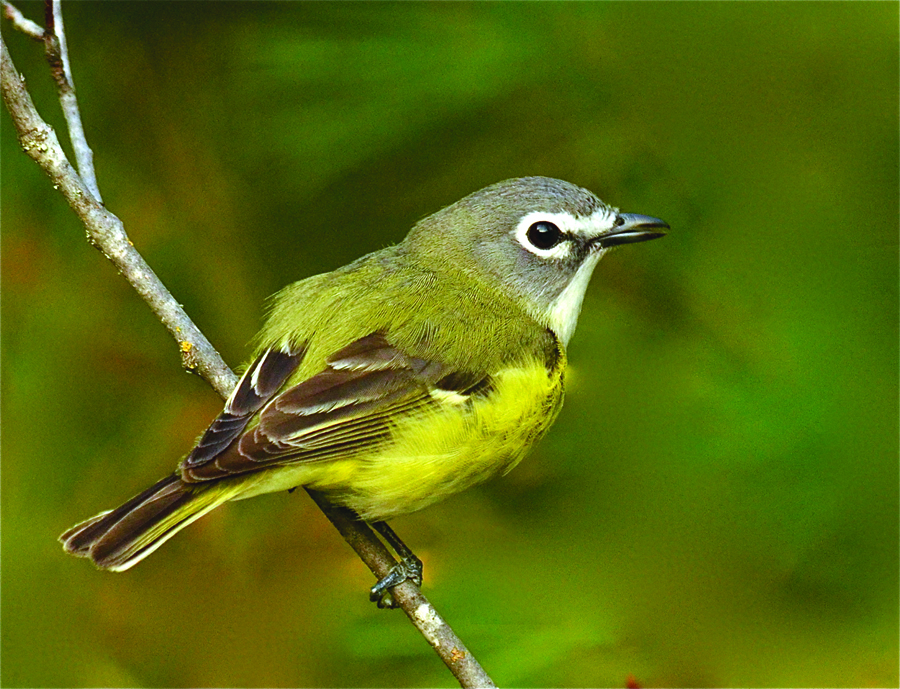Spring migration in Upper Peninsula ends, summer jubilee begins
- A blue-headed vireo perches on a tree branch. (Scot Stewart photo)
- SCOT STEWART
A blue-headed vireo perches on a tree branch. (Scot Stewart photo)
“Early summer days are a jubilee time for birds. In the fields, around the house, in the barn, in the woods, in the swamp – everywhere love and songs and nests and eggs.” — E.B. White
With the exception of just a few migrant birds still attempting to make their way farther north to breeding grounds in boreal forests or tundra wetlands, spring migration is over in the Upper Peninsula. Just a few, like a limping sanderling, can still be found along the shoreline of Lake Superior.
Lingering shorebird migrants were still being found on the Lower Harbor breakwall in Marquette earlier this week after the big thunderstorms Monday hit the area. Migrant sandpipers and plovers have found an overabundance of midges on the rocks, concrete and in the crevices of the breakwall this spring, allowing them to linger until healthy or at least well-fed, before continuing on northward. This past week more than a dozen semipalmated sandpipers, two semipalmated plovers, a white-rumped sandpiper and a sanderling were seen feeding on the breakwall. It was an interesting group. The plovers were more advanced in their breeding plumage than a single plover seen a few days previously. The white-rumped sandpiper, a rare visitor in the U.P. in spring, was seen associating with the plovers more than with a flock of semipalmated sandpipers. The sanderling was favoring its right leg and was also spending most of its time with the plovers.
The midges are aquatic in their early stages, living in the lake bottom sediment. Adults emerge as flying, flocking insects, sometimes called “blind mosquitoes,” because they don’t bite. The adults only live three to five days, because they do not feed. They swim, mate, lay their eggs on the water surface and die. Under the right conditions, egg masses sink, hatch in a few days, and can develop the next generation in three to five weeks.
Some hatches are big — the current hatch is one of the biggest seen in the Lower Harbor in many years. It now seems to be winding down and as the number of midges wane, the birds will probably drift off. A few tree, barn and even one northern rough-winged swallow and a song sparrow have been seen feeding on the midges too.

SCOT STEWART
The Lake Superior shoreline of Marquette was the site of another discovery — a laughing gull on June 12. A rare vagrant to this area, this gull does not travel around the Great Lakes the way other gulls like the black-backs, glaucous, iceland and Thayer’s do. Winter residents of the eastern Gulf Coast, Central America and the coasts of northern South America, laughing gulls do summer on the Atlantic Coast of the Mid-Atlantic and New England states.
As these migrants finally leave, birders will turn to the summer’s singers and breeders. A Marquette County group explored an area south of Gwinn last weekend to survey the species present and found a great array of warblers and other summer residents. The route explored was off County Road 438 on Kate’s Grade. Among the most notable were 18 species of warblers including 29 ovenbirds and five golden-winged, three Tennessee and 19 Cape May. Also seen were: four species of thrushes, hermit and wood, plus veeries and robins; four species of flycatchers, least, alder and four yellow-bellied and eastern wood-pewee; and four blue-headed vireos.
In Manistique a pair of red-headed woodpeckers has been seen adding to hopes they are nesting there. Once, more widely distributed in the U.P., including at least several nests in the city of Marquette in the 1970s, breeding red-headed woodpeckers have become rare across the entire area.
Monitors and birders alike will be watching pebble beaches across the the state and especially several key areas of the U.P. for nesting endangered piping plovers. Once nests are located, fences are erected around nests in most areas to prevent foot, dog and vehicle traffic from disturbing the nesting pairs. The fences also provide some protection from predators including peregrine falcons and merlins. Statewide, this species has seen slow gains in numbers, due in large part to the volunteer monitors.
Regular monitors and counters are no longer working at Whitefish Point in Chippewa County, having finished up their work at the beginning of June. Counters will return again at summer’s end to track fall migration. Even though there is no working staff there, it continues to be a great spot to see summer birds.
There are plenty of other locations to keep track of summer birds. One of the best, Seney National Wildlife Refuge, offers birding on many different levels. There are plenty of trumpeter swans, common loons, bald eagles, osprey, merlins, ring-necked and wood ducks, sandhill cranes and American bitterns, visible along the 7-mile long Marshland Drive by car. There are also miles of other roads closed to vehicle traffic but open to bicycling and hiking, and stretches of the nearby Manistique River open to canoeing. Trumpeter swans are among the most easy to find — with one of the pools on the refuge home to 60 or more non-mating swans. Lots of singing, blooming roses, mild days — it is a jubilee!
EDITOR’S NOTE: Scot Stewart is a teacher at Bothwell Middle School in Marquette and a freelance photographer.





